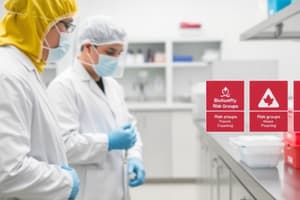Podcast
Questions and Answers
What are the three bloodborne pathogens of greatest concern to healthcare workers?
What are the three bloodborne pathogens of greatest concern to healthcare workers?
Hepatitis B virus (HBV), Hepatitis C virus (HCV), and Human immunodeficiency virus (HIV).
Describe the role of engineering controls in minimizing exposure to bloodborne pathogens.
Describe the role of engineering controls in minimizing exposure to bloodborne pathogens.
Engineering controls are devices that isolate workers from hazards, such as self-sheathing needles and sharps disposal containers.
What should a worker do immediately after an exposure incident occurs?
What should a worker do immediately after an exposure incident occurs?
Wash the affected area immediately with soap and water and contact a supervisor right away.
List two examples of work practice controls that help prevent exposure to bloodborne pathogens.
List two examples of work practice controls that help prevent exposure to bloodborne pathogens.
What is the importance of standard precautions in healthcare settings?
What is the importance of standard precautions in healthcare settings?
What role do engineering controls play in clinical laboratories handling infectious hazards?
What role do engineering controls play in clinical laboratories handling infectious hazards?
How are pathogenic organisms classified by risk groups, and which group represents the highest risk?
How are pathogenic organisms classified by risk groups, and which group represents the highest risk?
What is the significance of determining risk group levels in a laboratory setting?
What is the significance of determining risk group levels in a laboratory setting?
What biosafety level do most clinical laboratories operate at?
What biosafety level do most clinical laboratories operate at?
What type of work is commonly conducted in BSL-3 laboratories?
What type of work is commonly conducted in BSL-3 laboratories?
Why are Risk Group 4 pathogens typically not handled in most clinical laboratories?
Why are Risk Group 4 pathogens typically not handled in most clinical laboratories?
What does the term Biological Safety Levels (BSL) refer to?
What does the term Biological Safety Levels (BSL) refer to?
What risks are associated with pathogens classified in Risk Group 2?
What risks are associated with pathogens classified in Risk Group 2?
What characteristics define 'flame resistant' lab coat materials, and do these materials typically offer chemical resistance?
What characteristics define 'flame resistant' lab coat materials, and do these materials typically offer chemical resistance?
When should disposable gloves be used in a laboratory setting?
When should disposable gloves be used in a laboratory setting?
List three factors to consider when selecting the appropriate gloves for chemical handling?
List three factors to consider when selecting the appropriate gloves for chemical handling?
Describe the steps to take regarding the maintenance of personal protective equipment (PPE) before use.
Describe the steps to take regarding the maintenance of personal protective equipment (PPE) before use.
What is the purpose of a Safety Data Sheet (SDS) in a laboratory setting?
What is the purpose of a Safety Data Sheet (SDS) in a laboratory setting?
What key information is included in a GHS-Compliant label?
What key information is included in a GHS-Compliant label?
Define bloodborne pathogens and give two examples.
Define bloodborne pathogens and give two examples.
What measures should employers implement to control exposure to bloodborne pathogens at a workplace?
What measures should employers implement to control exposure to bloodborne pathogens at a workplace?
Why is it important for healthcare workers to be aware of bloodborne pathogens?
Why is it important for healthcare workers to be aware of bloodborne pathogens?
What is recommended to do with disposable gloves after use?
What is recommended to do with disposable gloves after use?
What are the key factors used by countries to classify microorganisms by risk group?
What are the key factors used by countries to classify microorganisms by risk group?
What distinguishes a BSL-2 lab from a BSL-3 lab in terms of safety equipment?
What distinguishes a BSL-2 lab from a BSL-3 lab in terms of safety equipment?
Identify two examples of specimens that may require additional PPE in a BSL-2 clinical lab.
Identify two examples of specimens that may require additional PPE in a BSL-2 clinical lab.
What is the role of PPE according to the CDC/NIOSH Hierarchy of Safety Controls?
What is the role of PPE according to the CDC/NIOSH Hierarchy of Safety Controls?
Under what circumstances might BSL-2 labs require enhanced precautions?
Under what circumstances might BSL-2 labs require enhanced precautions?
What biosafety level is appropriate for handling enteric pathogens like Salmonella?
What biosafety level is appropriate for handling enteric pathogens like Salmonella?
Describe the significance of local availability of effective treatment in microorganism classification.
Describe the significance of local availability of effective treatment in microorganism classification.
What specific measures are taken in a maximum containment BSL-4 laboratory?
What specific measures are taken in a maximum containment BSL-4 laboratory?
How does the presence of appropriate vectors influence the risk categorization of a microorganism?
How does the presence of appropriate vectors influence the risk categorization of a microorganism?
What types of personal protective equipment (PPE) might be added in a BSL-2 enhanced setting?
What types of personal protective equipment (PPE) might be added in a BSL-2 enhanced setting?
What is the first step in selecting appropriate PPE in a laboratory setting?
What is the first step in selecting appropriate PPE in a laboratory setting?
Why are prescription glasses inadequate for eye protection in the lab?
Why are prescription glasses inadequate for eye protection in the lab?
In what circumstances should safety glasses be worn instead of chemical splash goggles?
In what circumstances should safety glasses be worn instead of chemical splash goggles?
List two key characteristics required for effective protective goggles.
List two key characteristics required for effective protective goggles.
What must be done if contact lenses become contaminated with a hazardous chemical in the lab?
What must be done if contact lenses become contaminated with a hazardous chemical in the lab?
What is the purpose of wearing a lab coat in a laboratory environment?
What is the purpose of wearing a lab coat in a laboratory environment?
What are the OSHA requirements for respirator use in the laboratory?
What are the OSHA requirements for respirator use in the laboratory?
When should face shields be employed in conjunction with other types of eye protection?
When should face shields be employed in conjunction with other types of eye protection?
What are the mandatory minimum PPE requirements in a laboratory?
What are the mandatory minimum PPE requirements in a laboratory?
What should be considered when determining the contact location for PPE protection?
What should be considered when determining the contact location for PPE protection?
Study Notes
Risk Groups and Biosafety Levels
- Pathogenic organisms are classified into four risk groups: Risk Group 1 (low risk), Risk Group 2 (moderate risk), Risk Group 3 (high individual risk), and Risk Group 4 (high individual and community risk).
- The risk group classification considers factors like pathogenicity, transmission, host range, local immunity levels, and availability of preventive and treatment measures.
- Laboratory biosafety levels (BSL) are designated from BSL-1 (basic) to BSL-4 (maximum containment) based on the design, containment, equipment, practices, and procedures.
- Most clinical laboratories operate at BSL-2, while some handle higher-risk work in BSL-3 labs.
BSL-2 Laboratory Practices
- Common specimens handled in BSL-2 labs include stool cultures, urine cultures, blood chemistry testing, antibiotic sensitivity testing, and Streptococcus testing.
- Examples of higher-risk specimens requiring additional precautions include suspected Neisseria meningitidis, Mycobacterium tuberculosis cultures, respiratory and wound aspirate specimens, and subculture positive blood cultures.
PPE for BSL-2 Labs
- Standard PPE for BSL-2 labs includes lab coats, nitrile gloves, safety glasses/face shields, and, at times, respiratory protection.
Enhanced Precautions (BSL-3 Practices)
- Enhanced precautions may be necessary in BSL-2 labs when handling organisms transmitted by inhalation or when working with high-risk pathogens. BSL-3-level practices may include double gloves, solid front gowns, and respiratory protection.
PPE Selection
- Identify all types of potential hazards in the lab, including chemical, biological, radioactive, and physical hazards.
- Determine the nature, location, and type of potential contact with the hazards.
- Consider the availability of engineering controls in the lab (e.g., fume hoods, glove boxes).
- Review safety data sheets (SDS) and operating procedures (SOPs) to determine appropriate PPE.
Mandatory Minimum PPE Requirements
- Protective eye wear
- Lab coat
- Closed-toe shoes
- Chemical resistant gloves (when working with hazardous substances)
Eye Protection
- Safety glasses with side shields are mandatory for the majority of laboratory tasks to protect from flying objects.
- Splash goggles should be worn when handling chemicals with a high potential for splash.
- Face shields should be used when handling large volumes of hazardous materials or when working with pressurized systems.
Respiratory Protection
- Respirators are subject to OSHA regulations, requiring medical questionnaires and fit tests.
- Engineering controls should be used as the primary method of preventing inhalation exposures, with respirators as a last line of defense.
Lab Coats
- Lab coats provide protection to the skin and clothing from incidental contact, prevent the spread of contamination, and act as a removable barrier in case of spills.
- The choice of lab coat material (e.g., splash-resistant, static-free, chemical-resistant, flame-resistant) depends on the identified hazards.
Hand Protection
- Protective gloves should be worn when handling hazardous materials, chemicals of unknown toxicity, corrosive materials, sharp objects, and extremely hot or cold materials.
- Disposable latex, vinyl, or nitrile gloves are generally sufficient for most lab work.
- When working with highly toxic or corrosive chemicals, the appropriate glove material should be selected based on chemical compatibility.
- Gloves should be inspected for damage before use.
- Reusable gloves should be cleaned after each use, while disposable gloves should be discarded after one use.
Safety Data Sheet (SDS)
- The SDS is a comprehensive document divided into 16 sections containing information about a specific chemical.
- Sections include product identification, hazards identification, composition, first aid measures, fire fighting measures, accidental release measures, handling and storage, exposure controls, physical and chemical properties, stability and reactivity, toxicological information, ecological information, disposal considerations, transport information, regulatory information, and other information.
Understanding Manufacturer Labels
- The original label from the supplier should be attached to the container and should include:
- Product Identifier (matching the SDS)
- Signal Word ("Danger" or "Warning")
- Hazard Statements (describing the nature of the hazards)
- Precautionary Statements (describing recommended measures to minimize risks)
- Supplier Identification (name, address, and phone number)
- Pictograms (graphical symbols conveying hazard information)
Bloodborne Pathogens
- Bloodborne pathogens are infectious microorganisms found in human blood that can cause disease.
- Common bloodborne pathogens include hepatitis B (HBV), hepatitis C (HCV), and human immunodeficiency virus (HIV).
- Needlesticks and other sharps injuries can expose workers to bloodborne pathogens.
- Employers are required to implement exposure control plans to reduce the risk of exposure to bloodborne pathogens, including engineering controls, work practice controls, PPE, employee training, medical surveillance, and hepatitis B vaccination.
Bloodborne Pathogens
- Bloodborne pathogens are infectious organisms that reside in blood and body fluids, primarily viruses.
- Healthcare workers may encounter Hepatitis B virus (HBV), Hepatitis C virus (HCV), and Human immunodeficiency virus (HIV).
- Ebola Virus Disease (EVD) exposure is less common for most workers, but healthcare workers have a higher risk.
OSHA Bloodborne Pathogens Standard
- Employers must have an Exposure Control Plan to protect workers from bloodborne pathogens.
- Preventive measures include Hepatitis B vaccination and adhering to Standard Precautions.
- Engineering and work practice controls, personal protective equipment (PPE), housekeeping, and labeling help in controlling exposure.
Standard Precautions
- Based on the principle that all blood and body fluids must be treated as infectious.
- Applies to:
- Blood
- Body fluids
- Secretions (except sweat)
- Excretions
- Non-intact skin
- Mucous membranes
Methods of Control
-
Engineering controls isolate workers from hazards. Examples include:
- Self-sheathing needles
- Sharps disposal containers
- Disposable resuscitation bags
- Biological safety cabinets
- Hand washing facilities
- Splash shields
-
Work practice controls dictate safe task execution. Restrictions include:
- No smoking, eating, drinking, applying cosmetics, or handling contact lenses near blood or OPIM.
- Food and beverages cannot be stored where blood or OPIM are present.
- No mouth pipetting.
Sharps Safety
- Sharps include objects that penetrate the skin (needles, scalpels, broken glass).
- Proper handling and disposal are crucial.
- Most hospitals use needle safety devices to cover needles after use.
- Sharps Safety Summary:
- Place sharps in puncture-resistant containers immediately after use.
- Use caution or safety devices when removing scalpel blades.
- Never recap, bend, shear, or break needles.
- Do not remove needles from holders or syringes.
- Do not fill sharps containers beyond the maximum fill line.
Exposure Incident
- An exposure incident occurs when blood or potentially infectious body fluid contacts mucous membranes or non-intact skin.
- Parenteral exposure involves piercing the skin barrier via needlesticks, cuts, or abrasions.
- If an exposure occurs:
- Wash the affected area immediately.
- Contact your supervisor immediately.
- Seek evaluation and treatment as directed.
Avoiding Exposure
- Follow safe work practices to minimize risks.
- Use appropriate engineering controls and PPE.
- Ask your supervisor for clarification on safe procedures.
Studying That Suits You
Use AI to generate personalized quizzes and flashcards to suit your learning preferences.
Description
Test your knowledge on the various biosafety levels and risk groups associated with pathogenic organisms. This quiz covers essential laboratory practices and the classification of biological materials based on their risk assessments. Ideal for students and professionals in the field of microbiology and biosafety.




